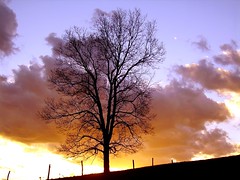Planting Trees and Shrubs
Source: WVU Extension Service

The success or failure of trees and shrubs to grow and produce the desired effects begins with proper planting.
Trees and shrubs planted around the home, in shopping centers, around schools, along streets, etc. are forced to grow in an artificial or unnatural environment where soil conditions, water tables, drainage, etc. have been altered. Therefore, it is necessary to make certain that the plants are properly installed and receive the best of care until they become established.
Now is the Time to Plant
Trees and shrubs should be planted in the fall after they have become dormant (about early November) or in the spring before new growth appears (around late March). Balled and burlapped trees and shrubs may be planted any time of the year provided they were dug during the dormant period and after planting receive ample water during hot, dry weather.
Planting Tips
- The planting pit should be dug a minimum of 1 foot wider than the earth ball or spread of bare roots. It should be at least six inches deeper than the earth ball and 2 to 3 feet deep for bare root plants.
- All planting pits should be dug with vertical sides, with the center slightly raised to aid in draining excess moisture away from the plant.
- Good drainage is essential, so the planting pit should be checked before setting the plant. Fill the pit with water. If the water drains out within six to eight hours, there should be no problems. If on the other hand, water is still standing, artificial drainage should be installed. Placing gravel in the bottom of the planting pit is of little or no value as it makes no provisions for removing excess water from the site.
- Backfill or planting soil should be of equal or better quality than the soil in which the plant originally grew. General recommendations call for a mixture of equal parts of organic matter, coarse sand and top soil. All backfill should be easily workable and free of debris.
- Many plants fail to live because they are set too deeply in the planting pit. When this occurs, the plants suffocate as sufficient air does not reach the root system. Balled and burlapped or container grown plants should be so planted that the earth ball rests 1 to 2 inches above soil level. This allows for settling to the proper depth. Apply mulch around the plant to protect the roots.
- Bare root trees and shrubs should be planted at the depth which they originally grew. A ‘collar’ is generally evident at the base of the stem or trunk indicating this depth.
- Never pull a plant from the container. Cut the container away from the root system and earth ball.
- Two people should be available when trees and shrubs are to be planted.
- Handle trees and shrubs carefully. Balled and burlapped plants should be carried by the earth ball, not by the trunk.
- Water trees and shrubs well after planting and keep the soil moist at all times.
- Mulch after planting.
- Guy or stake trees in position to prevent roots from becoming loose in the soil.
- Planting should not be done when the soil is wet or soggy. The soil should be loose and workable.
Written by:
Clifford W. Collier, Jr, Extension Specialist, Professor, Landscape Architecture
Revised by John Jett, Extension Specialist, Horticulture
Publication 467,
West Virginia
University
Extension Service